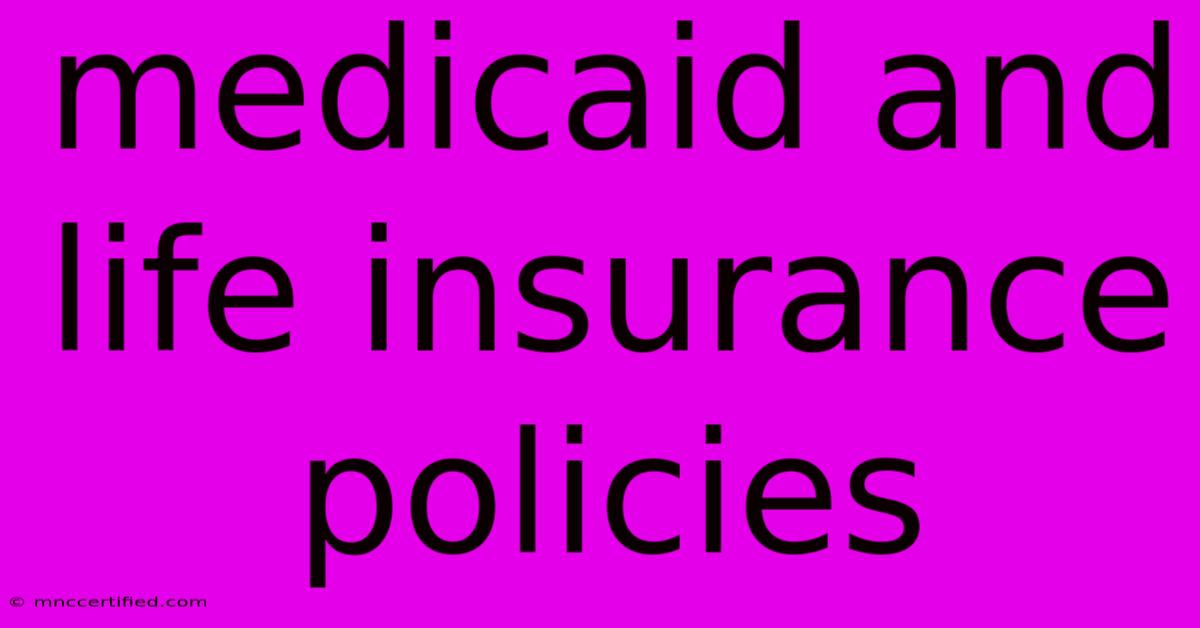Medicaid And Life Insurance Policies

Table of Contents
Navigating the Intersection: Medicaid and Life Insurance Policies
Navigating the complex world of healthcare and insurance can be a daunting task, especially when you're dealing with two significant programs like Medicaid and life insurance. While these programs serve distinct purposes, their intersection can raise questions and concerns for individuals and families. This guide aims to provide clarity on how Medicaid and life insurance policies work together, highlighting potential implications and considerations.
Understanding Medicaid
Medicaid is a government-funded health insurance program designed to provide essential healthcare coverage to low-income individuals and families. It covers a wide range of medical services, including:
- Hospitalization: Covers inpatient care, emergency services, and other hospital-related expenses.
- Doctor visits: Includes checkups, preventive care, and treatment for illnesses.
- Prescription drugs: Covers a range of medications, often with cost-sharing requirements.
- Mental health and substance abuse services: Provides access to mental health counseling, therapy, and addiction treatment.
- Dental and vision care: Offers basic dental and vision services, though coverage varies by state.
Eligibility for Medicaid is determined based on income and assets, and it is essential to understand the specific requirements in your state.
Life Insurance: A Financial Safety Net
Life insurance provides a financial safety net for loved ones in the event of your death. It pays out a death benefit to your beneficiaries, which can help cover:
- Final expenses: Funeral costs, burial expenses, and outstanding debts.
- Income replacement: Financial support for dependents who rely on your income.
- Mortgage payments: Help cover housing costs for surviving family members.
- Education expenses: Provide financial assistance for children's education.
The Impact of Medicaid on Life Insurance
While Medicaid and life insurance operate independently, there are important points to consider when both are in play:
- Medicaid Spend-Down: In some cases, Medicaid requires individuals to "spend down" their assets before becoming eligible for coverage. This might include selling certain assets like life insurance policies.
- Asset Protection: Life insurance policies are generally considered assets and could be subject to Medicaid's "look-back" period. This means Medicaid may review your asset history for a certain period to ensure you haven't disposed of assets to qualify for benefits.
- Medicaid Estate Recovery: Medicaid has the right to recover some of its costs from your estate after your death. This could include recovering a portion of the death benefit from a life insurance policy.
Important Considerations
-
Consult with a Professional: It's crucial to seek advice from a qualified financial advisor or an estate planning attorney who specializes in Medicaid and life insurance. They can help you understand the implications of your specific situation and devise strategies to protect your assets.
-
State Regulations: Medicaid rules and regulations vary significantly from state to state. Understanding the specifics of your state's program is essential.
-
Policy Review: Review your existing life insurance policy to see if it includes any provisions that might be affected by Medicaid. Consider updating your beneficiaries and policy structure as needed.
-
Explore Alternatives: Explore alternatives to traditional life insurance policies, such as burial insurance or final expense insurance, which may offer more flexibility or asset protection.
Navigating the Path Forward
Understanding the interplay between Medicaid and life insurance policies is crucial for individuals and families seeking financial protection and healthcare coverage. Consulting with a qualified professional can help you navigate these complex issues, make informed decisions, and protect your financial future.

Thank you for visiting our website wich cover about Medicaid And Life Insurance Policies. We hope the information provided has been useful to you. Feel free to contact us if you have any questions or need further assistance. See you next time and dont miss to bookmark.
Featured Posts
-
The Ohio Casualty Insurance Company
Nov 12, 2024
-
Bondo Professional High Bond Filler
Nov 12, 2024
-
Megan Fox And Mgk Baby On The Way
Nov 12, 2024
-
Parsons Mc Carthy Comments Misinterpreted
Nov 12, 2024
-
1991 Wcw Trading Cards Most Valuable
Nov 12, 2024